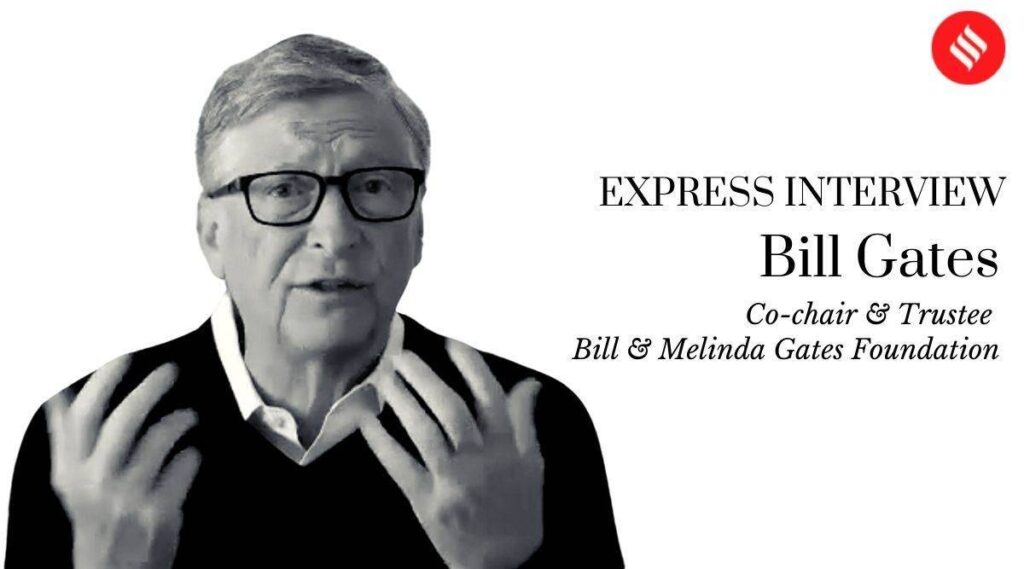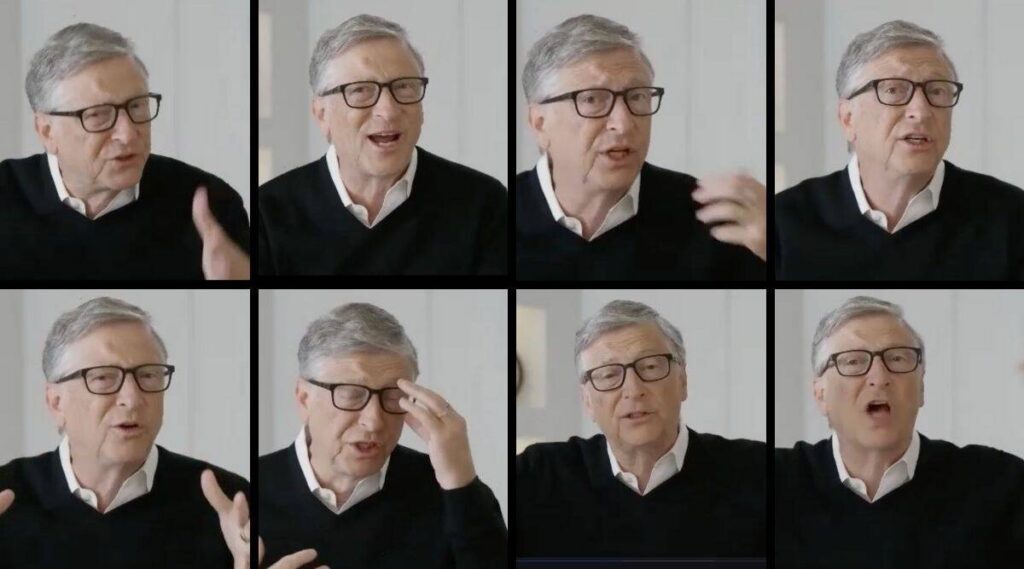With Melinda Gates, Bill Gates chairs the Bill & Melinda Gates Foundation, the world’s largest private charitable foundation.
Written by Anant Goenka – This article was first Published on January 30, 2021 at – : https://indianexpress.com/article/india/bill-gates-interview-covid-19-pandemic-vaccine-7165804/

With Melinda Gates, Bill Gates chairs the Bill & Melinda Gates Foundation, the world’s largest private charitable foundation. After their annual letter, on the challenges of the pandemic was released Wednesday, he spoke with Anant Goenka. Excerpts:
Anant Goenka: Let me start with a book I read on your recommendation: Factfulness. Its central thesis is that facts show how the world is actually doing much better than it ever was, that it’s less violent, more equal, less poor…How much has the pandemic derailed humanity from this thesis?
Bill Gates: The pandemic is certainly a gigantic setback, and it’s actually hard to measure because although the economic figures are clear, there are lots of mental health problems; there’s a lot of loss of education… Somewhere between two to five years from now, we will get back to where we were before the pandemic came so it’s not a permanent reduction. It is almost like World War in terms of scale, because even countries without many deaths have seen their economies devastated.
The chance of a pandemic and naturally caused pandemic is probably something like 2 per cent per year. And so, there’s a good chance that we can go another decade without a pandemic. Now we shouldn’t just assume that…we should make sure our governments are building up the diagnostic capacity, the therapeutics and vaccines so they could respond so quickly that an epidemic like this one would be a fairly minor event.
And we saw in some countries that moved quickly like Australia, South Korea, that in fact the damage to their countries has been far far less.

When the pandemic does happen, you think we are better equipped today, but still, not as well as we could be?
The warnings that were made through my TED talk and through other experts back in 2015 were largely ignored. A group called CEPI (Coalition for Epidemic Preparedness Innovations) was created that has made some contributions to this pandemic. But you know (that’s) not even 5% of what should have been done.
The workers normally funded to do polio or malaria work have been shifted over and that helped a lot but we don’t have a large core of people — like 3000 or 4000 —standing by to help with pandemics.
There are clear things we need to get started on: better diagnostic tools; surveillance; tonnes of R&D efforts building on the successes that we had during this pandemic.
So we won’t be fully ready for the next pandemic for over five years. We have to hope you’re right that we don’t get struck again when we don’t have all these these tools in place.
Is there any other lesson from the pandemic… linked to the way we live, how a lot of it is quite at odds with nature? Do you think the pandemic is a wake-up call? Or, is the correlation between the way we live and this pandemic not clearly established yet?
Usually, when you have a near-term crisis, your focus on problems that are further out is greatly reduced…Fortunately, with this pandemic, it’s not the same. We’ve had enough bad weather events and enough, young people talking about the climate problem that interest levels are quite high. And so you see governments taking some of the recovery money, like the European Union, and designating that to climate-related projects.
This is good news. We have a lot of energy, about climate, but we don’t really have a plan, because there’s so many sources of emissions — cement and steel, it’s not just cars or electricity, it’s many other things as well. And so realising your government needs to think ahead on your behalf and avoid big problems, hopefully, that’s been enforced by this pandemic… that you need those experts.
So what we saw in the pandemic, we have Pfizer working with BionTech. We have AstraZeneca working with Serum; these types of connections formed just to solve the problem — they are not driven by normal market, profit-seeking, but rather just humanity coming together for the coronavirus enemy, I think it’s really exciting.
The world’s highest-volume vaccine factories are Indian and that’s why our foundation has close relationship with those manufacturers and we arranged payments for the vaccines that have got the high-quality approvals.
I know that your relationship has largely been with Serum. Do you have a view on the indigenous vaccines being developed locally in India?
Worldwide, there are almost 150 efforts to make vaccines. And that’s fantastic. You know most of those, even won’t work, or they won’t arrive in time. And so, the vaccines that really count are the ones that have gone through the gold standard regulators, because people do worry about safety and effectiveness and that they can be made at low cost and very high volume.
mRNA vaccines of Pfizer and Moderna are fairly costly and they are hard to scale up so they are part of the solution, but we won’t get many of those vaccines for developing countries.
You know Pfizer committed 40 million, and yet we need more than 2 billion. And so our hopes are really pinned in terms of getting there quickly to create equity, they’re pinned on Astra Zeneca, Johnson and Johnson, and Novavax that will have, you know, high quality Phase 3 trials.
Whether other vaccines, you know, get that type of data, and can be made in volume is unclear — if so, that would be great. The more the better. But right now, those 5 are likely to be the primary ones that immunize the world.
One of the mysteries is how the Covid curve has behaved differently in India and developing countries versus in the US, Europe, UK. Last week, India clocked 1 in a million infections, US clocked 65 per million infected. What do you make of this?
One piece of good news about this pandemic is that if you are younger, if you work outdoors, the risk is much, much lower. So countries at India’s level of economic development, or earlier than that, very few of them have had a bad epidemic in terms of death rate. Now some countries have lots of multi-generational households, and that works against you, because then the risk of infection in the household is higher, that somewhat offsets, you know, the urban density of Indian and those multi-generational households. But you’re absolutely right, the fatality rate in the younger population is nowhere near as high as some of the countries in the West where their age pyramid looks very different.
Let’s switch gears to charity that you evangelise. In getting them to be philanthropists, is there any difference you find while speaking to a billionaire from a rich country and one from a country like India?
Well, the only difference is that if you’re a billionaire in a rich country, you should consider sending some of your money outside of your country, you will probably want to spend some in the country, you know, to reward the great atmosphere that allowed you to have the success like our foundation spends on United States education, trying to improve that since Melinda and I benefited from having great education.
If you’re a billionaire in, say, India, or in Africa, you will probably give most of your money in your own country because India has plenty of primary health care problems… tropical diseases that are very bad there. And I’m always trying to get Indian billionaires interested in these causes. I hope we can get them even more enthused about health or education, dealing with the basic inequities.
Do you see a distinction between the Eastern way of giving versus the Western way of giving?
The main difference is that when you have families that have been rich for a long time, they are like a dynasty and they mostly give away their income, they don’t give away their principal. When you have someone who’s made a recent fortune, like in technology, they are often willing to give away, 50% to 90% of all of that, because they don’t think of their family as having that fortune, they think that there was a stroke of good luck. So Mark Zuckerberg plans to give 99% away, I plan to give 95% away, you know, so we are not starting an ongoing thing, even though we will be generous to our children.
One of the things your and Melinda Gates’s annual letter talks about is exaggeration of inequities… there has been a setback on the gender front.
The condition of women in poor countries is even worse than that of men – their access to education, their ability to even get out and talk to other women. They are doing very tough menial work for very, very long hours, often the entire day. And their ability to protect themselves from violence or to make choices is very restricted. So economic development, fortunately, starts to change that… the more urban areas start to change that.
So when you have a huge setback like this (pandemic), we need to remind ourselves that this is tougher on the woman. Even in rich countries…women often do more of the housework, and helping the kids with their online education, often falls to the Mom…Melinda’s very articulate there are gender-focused policies that can reduce some of the increased burden on women.
Is there any technology solution that you see coming in to bridge these inequities that have suddenly gotten exaggerated?
We have certainly accelerated investments in online learning. Right now online learning requires an internet connection and, you know, a PC-like device. And then it requires teachers who created that content and figure out how to engage the students…
I’m an optimist that online has a huge promise for improving education even after the pandemic. Kids can immediately get feedback when they’re confused, they can meet up with other students even though they’re not in the same place. And, of course, if we improve education, that helps the entire economy. Human resources are the main resource in all countries, particularly in India. So how can the Indian education system be better — that’s fascinated me. Because it’s key to how fast the country moves forward.
The pandemic has underlined how irreplaceable technology is…What are your thoughts on the rules of engagement with technology…do you think there has to be a new way for citizens and for regulators to think about engaging with Big Tech.
Well that’s constantly evolving. You know what, how do we make sure that all companies are innovating on behalf of their users and what should the boundaries be.
India has ruled that Amazon can’t sell their own products on their marketplace and other countries don’t have that, but I do think other countries are debating… As technology evolves, particularly now that it’s gotten into the communications realm and the delivery of news… the government’s going to be looking at how do you stop anti-vaccine misleading things from being promoted… something (that pits) one ethnicity against another… how do you curb that? Even a politician might say something that is stirring up trouble, how you moderate those things will be discussed, including telling the technology companies how the country wants it handled.
